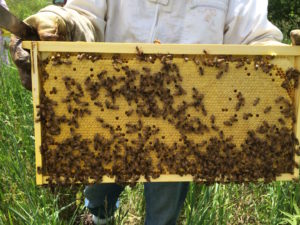There is SO much happening in hives this time of year. Colonies are expanding, and the weather has allowed for massive nectar (soon to be honey?) collection. We’ve been busy mentoring newbees, and taking calls and answering texts about similar issues.
Hopefully your colony is booming. Here are some amazing statistics to consider. According to Dr. Larry Connor, who spoke at to Kalamazoo Bee Club last week, a full deep frame of bees yields 5,000 – 6,000 bees. A vibrant queen in a thriving hive will lay a frame every 2-3 days. The package you installed contained only about 10,000–so as that queen reaches her peak laying, the hive’s growth is exponential (and awesome!) It is a fun time of year with colonies expanding so rapidly. It means swarms, lots of nectar gathering, queen cells, and splits to be made to increase the number of hives. (We had some mentees with such powerful nucs that yes, we’ve already split them. They doubled their number of hives their first two months of beekeeping.)

Love this queen! A bee-to-be in practically every cell. In a cell where there isn’t the brown flat cap of worker brood, there’s typically a larva, or honey, or pollen. This wall-to-wall laying pattern is delightful to discover.
This ever-increasing growth rate also means a variety of challenges. I outline the ones we’re seeing frequently as we work our 30ish hives and work with newbees. These challenges include being honeybound (give the queen room to lay), queen cells, ventilation, feeding — just to name a few.
To read the entire blog, please click here.
There’s lots going on in your colonies this time of year. Mark your calendar to attend the club’s July meeting, where we’ll discuss how to protect your bee-loved bees against the predatory mites.
I learn something I didn’t know every time I read your blog. Thank you Charlotte.???